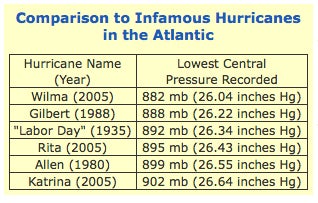On Oct. 12, 1979, Super Typhoon Tip's central pressure dropped to 870 mb (25.69 inches Hg), the lowest sea-level pressure ever observed on Earth, according to NOAA. Peak wind gusts reached 190 mph (306 kph) while the storm churned over the western Pacific.
Besides having unsurpassed intensity, Super Typhoon Tip is also remembered for its massive size. Tip's diameter of circulation spanned approximately 1,380 miles (2,220 km), setting a record for the largest storm on Earth. The storm's huge diameter was exactly the same as the distance from New York City to Dallas.

On supporting science journalism
If you're enjoying this article, consider supporting our award-winning journalism by subscribing. By purchasing a subscription you are helping to ensure the future of impactful stories about the discoveries and ideas shaping our world today.
A total of 40 U.S. Air Force aircraft reconnaissance missions flew into Typhoon Tip, making it one of the most closely monitored tropical cyclones, according to a post-analysis written by George Dunnavan and John Diercks.
Typhoon Tip slowly weakened before making landfall in southern Japan on Oct. 19, 1979. However, the typhoon was still the most intense to hit Japan's main island of Honshu in more than a decade. Tip claimed the lives of 86 people and injured hundreds of others.
The extreme winds of Tip knocked over a gasoline storage tank, causing an explosion and fire that spread rapidly through a U.S. Marine Corps camp at Mt. Fuji. The Associated Press reported that one person was killed and dozens of others were injured.

Extensive flooding destroyed more than 20,000 homes in Japan, while hundreds of mudslides occurred.
High-rise buildings in Tokyo swayed from the high winds as the typhoon struck.

Image of Typhoon Tip at its strongest on Oct. 12, 1979, from NOAA.
From AccuWeather.com (find the original story here); reprinted with permission.